Indoor dog litter boxes are one of the ways to train puppies how and where to keep their waste and litter. However, it’s easy to get lost with various options out there. To avoid wasting time and money from buying the wrong kind, let us help you understand the different types of dog litter trays and what’s the best type.
Contents
Different Types of Dog Litter Boxes
According to Breeding Business, “Litter boxes come in various types, and each has a specific purpose. No one type is better than all the others. This is a very case-specific pet product.” Take into consideration that one particular tray may be suitable for one breed, but not for another dog. So, let’s start by differentiating the various types of pet potties.
Indoor Dog Litter Boxes
Indoor litters come in two standard options – the conventional litter box and pee pad holders.
A conventional litter box is the simplest and most popular indoor-potty. Hence, they call it ‘conventional.’ These are almost similar to litter trays for cats, except that they feature puppy-friendly details like more full sides or higher walls. Some littering trays may or may not have a roof because some pets don’t feel comfortable with ceilings and would instead want an open one.
Pee pad holders are almost similar to a conventional potty box with a large plastic frame except that it uses large sheets of paper, fabric, or a combination so that the pooch will have a better place to poop and pee. These are like diapers that will only hold the poop in place and absorb litters if you put sheets of paper underneath. Pee pad holders offer more permanent solutions for poop training, but dogs often end up playing and tearing it apart if not appropriately trained.
Real Grass Pet Litter Boxes
Real grass matches the ‘feels’ of the outside environment that a dog breed experiences when pooping outdoors. This kind is the best option if your dog enjoys relieving themselves outside and playing on the grass. Therefore, these grass boxes would highly appeal to them and won’t end up breaking the tray apart. Most real grass dog litter boxes feature real and live patches of grass, designed for dog’s pooping and littering.
Manufacturers grow these grasses hydroponically, which means it needs no soil and minimizes the mess whenever your dog starts digging in. Therefore, expect that it will wear out and dry eventually after one to three weeks, so regular replacement is a must. This kind is more expensive than conventional litter boxes and synthetic grass patches, but it provides higher quality for your pup’s training.

Source: Natural Dog Owner
Synthetic Grass Dog Litter Boxes
As opposed to real grass, synthetic grass dog litter trays are not “alive”. They use an antimicrobial coating to prevent bacterial colonization. Moreover, synthetic grass doesn’t require high maintenance. You have to remove solid wastes and wash it with soapy water to ensure the cleanliness of the potty. Another good thing about synthetic grass is that it will save you money from replacing the patches of grass since it won’t die even without sunlight. However, take note that some breeds can’t appreciate synthetic, and would still prefer real grass. Some dogs might end up chewing on its blades, instead.
Grate Dog Litter Boxes
Grate, or plastic, puppy poop trays are straightforward to use because of its simple meshed mechanism and design. Moreover, it works well to keep the poop on top while the holes allow the pee to flow underneath. Then, the bottom of the crate has pads to absorb any liquids. This is a very easy to clean option.
The grate system helps keep your home free of any mess. However, using grates will expose the stools of your dog. As a result, it can produce smelly and strong odors at home if not disposed of sooner. Plastic litter trays are excellent for urine and defecation. Your dog would step on top of the crate, and he can start doing his business.

Source: DogsAholic
What’s The Best Kind of Puppy Litter Box?
The best kind of puppy potty boxes depends on the owner and the breed’s preferences. Some puppies like digging holes, or feel the grass before they can poop or litter. On the other hand, some breeds are comfortable doing their thing on standard surfaces. It’s a matter of observation and probably trying out several kinds of litter trays to succeed in this training.
Another factor to consider is the right size of the pet litter tray. For puppies, small litter boxes are distinct options. However, you will have to replace it as soon as they grow. Anticipate the length and size that the breed would reach once fully matured. You need a tray that is roomy enough for your dog to browse or walk a little when choosing the ‘perfect spot.’ Then, make sure that the dog will be willing to use it.
As an example, toy breeds are better with a small pet litter tray so that the puppy wouldn’t feel like he’s entering a giant hole. A large dog litter box for medium-sized pooch would provide some extra room. On the other hand, giant dog breeds may need an extra-large dog litter box. Finally, only buy from credible and trusted brands. It guarantees quality and longevity of use.
What To Look For A Dog Litter Box?
A puppy litter box must be functional, hygienic, clean, and comfortable for your pooch and the space in your home. More than the design and appearance, it is essential to have some additional features like drainage holes, waste filtering, and waste trays. Puppy litter trays are ideal for indoor potty use, and if you don’t have a garden space.

Source: Wag
Why Use A Puppy Litter Box?
You must use a pet potty if you have limited space at home or no outdoor space that is easy to access. You have to teach your dog where to poop and litter, and use a litter box just like how people use a bathroom. They may not be able to clean it afterward, but the important thing is to teach the breed not to do their business in any other part of the house. Moreover, a dog litter box is helpful for senior dogs that struggle to hold their bladder long enough to make it outside. Another reason could be some breeds may have difficulties in fully adapting to traditional outdoor housebreaking. For example, most Maltese breeds have a tiny bladder. So, a litter tray is what they need.
Dog potty trays provide permanent solutions for all dog owners. However, choosing the right kind is crucial. Such dog litter boxes are best to use when you live in a high-rise condo or don’t have a proper garden, and you want to train your puppy when pooping and littering. Make sure to buy a litter box specially intended for dogs. Then, place it in very accessible and comfortable areas for your furry friend to use.
